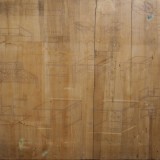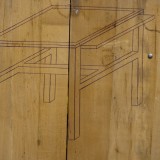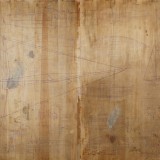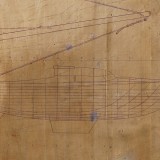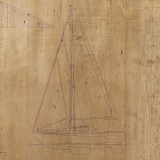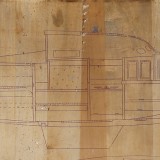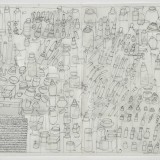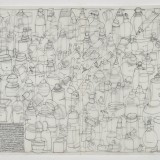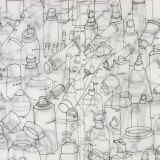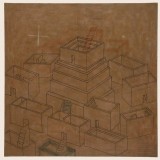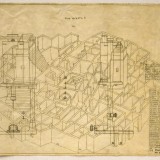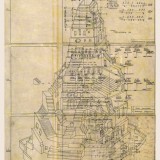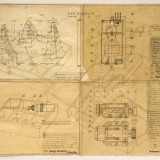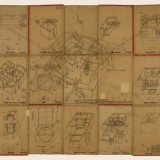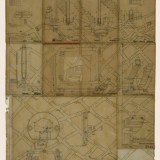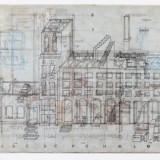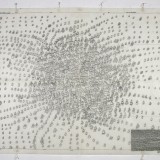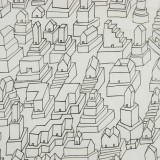Jolanta Wagner
Jolanta Wagner works in the media of drawing, painting and 3D actions. In 1973 she graduated from the Art College (now Academy of Fine Arts) in Łódź. Since 1974 she has been a lecturer at the same school, currently running the Studio of Interdisciplinary Visual Activities in the Department of Industrial and Interior Design. She has had over 50 individual shows and around 300 group exhibitions in Poland and internationally. She is a laureate of many awards, among others the Grand Prix of Biennale-Bosnia (1990). She also received bursaries from the Royal Academy of Art in London in 1982, Ministry of Culture in Denmark (1993, 1997), and from the American CECIP Foundation in New York (1999, 2002). Jolanta Wagner is also an instigator of the project I Here and Now – international intermedia workshops, which so far took place in Łódź and Milan. In 2002 she received a professorship. Most often Jolanta Wagner starts her work from drawing. As she wrote on her web site, drawing is her everyday life and at the same time a registration of it. I draw all the time, almost unceasingly. (…) I register my life and create a kind of documentation: diaries, calendars, books, maps… notebooks on everyday matters. Matters which are objectively petty and unimportant, only important for me.
Through her art the artist tries to familiarise the world, put things in order, discover the principles that rule reality. The arranged world becomes a safe world for her. Putting things in order is connected with making choices, focusing on certain things and renouncing others. The artist is faithful to the principle: In art »less«, »more humble«, »simpler« most often means »better«. Creating – putting things on order forces us constantly to make choices.
Jolanta Wagner for many years has created her General Registry. It is an inventory of everyday items and the surrounding reality, which the artist has registered by drawing. The works created on tracing paper more often resemble technical than artistic drawings, but let’s not be deceived. These are works for the careful and sensitive viewer who can notice the subtleness of intermingling strokes of overlapping layers of tracing paper, the usage of yellowish paper or a background such as an old drawing board. When looking attentively at the strokes, we see that precise lines were not drawn using a ruler, but by the steady hand of the artist.
Jolanta Wagner started to create the General Registry in the 80s. It was a difficult time for her. She took care of her young son and the reality of martial law increased the feeling of isolation, the hopelessness of existence and the uncertainty of tomorrow. Registering the everyday life and petty things had therapeutic impact, engaged the mind and was a way for the artist to survive. Now the times have changed, but the custom of making notes, a kind of documenting or archiving reality remains.
The artist registers cosmetics, plates, everyday items of use associated with her home, intimate space, but also objects from the public environment – architecture, urban layouts, city maps etc. and on drawings she cumulates empty cosmetic bottles – empty perfumes, powders, lipsticks. She limits however the images of items to a synthetic graphic sign. Drawn with a black, thin stroke, they fill the entire plane of the work and evoke associations with picture writing, they are the artist’s private alphabet.
In the inventory of architecture the artist uses various types of composition and perspective. The drawing The plan of town A resembles drawings of the medieval maps of towns, with buildings cumulated in the centre. When we look at the drawings of individual buildings we see that they are very strange, as if some mysterious civilisation built them. They are situated often on high stairs, pedestals, they don’t have windows, some resemble zikkurats or the buildings by the Maya civilisation. The plan of town G is a drawing with notes on dimensions plus technical descriptions. The artist used yellowish tracing papers, so the drawing has a colour quality – subtle warm tones. In the work The plan of a house in Piotrkowska St. apart from yellowish paper she also used red strokes. In her drawings the artist uses an old, traditional technique – she draws with a quill and ink, and she covers the completed with wax. The drawings on old tracing paper look like found plans by some mysterious constructor.
In the General Registry the artist included also the works by the Łodź avant-garde – the items designed by Władysław Strzemiński and Roman Modzelewski. I document objects which I once came across. These are items designed by Władysław Strzemiński and Roman Modzelewski. I register, make an inventory and systematise them based on the author’s sketches, and also depending on my own memory. I draw using tools which not so long ago were very popular among designers, but are now withdrawn from use: French curves, triangle, compass, razor, carbon paper and a pen which doesn’t write anymore. As a background I use old drawing boards 150x200 cm, bought from a architecture office Miastoprojekt-Łódź which was closed a few years ago.
The artist showed the drawings in 2012 during the Art and Documentation Festival. On one of them she drew from memory, the furniture designed by Władysław Strzemiński: a desk, bed, a couch that she saw when visiting professor Roman Modzelewski. A second drawing shows the yacht Amulet designed by Roman Modzelewski. Modzelewski worked on it at the end of the 60s together with his students, including Jolanta Wagner. The yacht was standing for a few months in a former sculpture studio of the Art College (now Academy of Fine Arts) in Łódź. The projects that were completed a couple of decades ago are modern in their form even today and never entered mass production. The author wants to keep the information and memory about them alive.
When I visited the house of prof. Roman Modzelewski in whose studio I studied painting, many times I sat in unusual armchairs which he designed (two of them are now in my house) and chairs designed by Władysław Strzemiński. Ms. Wera Modzelewska offered me tea, which I drank while sitting at a black and yellow desk of Strzemiński, very similar to the ones that I drew whilst being inspired by his projects (the desk currently belongs to Muzeum Sztuki [ the Art Museum] ) – says the artist.
Jolanta Wagner has worked out a characteristic language. One may use the word “style”, which was once valued in art, which today is passé. The works by Jolanta Wagner are however very contemporary. They enter into a relationship with works of other types (architecture, art history), so they are not intertextual. Jolanta Wagner builds her narration in reference to other narrations and one is contained within the other. The drawings of cosmetics or items which are associated with everyday life of a woman one may interpret in a gender context. Was the artist thinking about it when she was creating her inventories? Perhaps not. But just as Jolanta Wagner makes inventories of her surroundings, art history tries to make inventory of artists… and this is hard to avoid.
Anka Leśniak
more at the artist's web site


